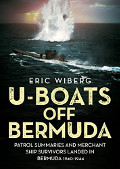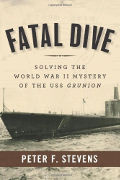Martial Justice
The Last Mass Execution in the United States
Whittingham, Richard
1997, United States Naval Inst.
ISBN 155750945X
281 pages, 29 photos
| Type. | General History |
| Pros. | Clear account of a complex set of events |
| Cons. | No index; otherwise, nothing major |
| Rating. |  |
 This book presents a detailed account of the events that led to the execution of seven U-boat sailors in an American POW camp in August, 1945. Accused and found guilty of the murder of a fellow POW, the seven were hanged consecutively in the space of three hours in the last mass execution in United States history.
This book presents a detailed account of the events that led to the execution of seven U-boat sailors in an American POW camp in August, 1945. Accused and found guilty of the murder of a fellow POW, the seven were hanged consecutively in the space of three hours in the last mass execution in United States history.
The first chapter sets the scene by describing Fort Leavenworth, the site of the executions, and the technical problem that putting so many men to death at once presented (a special gallows had to be constructed for the purpose). The next chapter provides background on the lives and brief careers of the seven enlisted men, the oldest of whom was 26 and the youngest 21 years old in 1945. Five had been shipmates aboard U-615; one had survived the sinking of U-199; and one had been a member of the crew of U-352.
The third chapter focuses on Werner Drechsler of U-118, who was discovered dead in the shower room of Papago Park prison camp on March 12, 1944, a mere six hours after his arrival there. Drechsler had been at Fort Meade since the end of June, 1943, where he participated in a scheme to gain intelligence from newly arrived prisoners. Introducing himself under various names and ranks, Drechsler used his friendly, open manner to encourage new captives to speak freely about their experiences and about military matters in general. This chapter describes how, in the seven months of his participation in this activity, rumors of a U-boat sailor turned traitor spread among the U-boat POW population as the men who had encountered him moved through Fort Meade into various camps.
The next two chapters recount the early events of that fateful Sunday in March when Drechsler, in spite of a previous stipulation that he should never be transferred to a regular camp, arrived at Papago Park. It did not take long for some of the POWs to recognize him and compare notes with one another to establish that this must be the Drechsler, also calling himself Leimi and Limmer, of whom they had heard, or to whom they had actually spoken shortly after being taken prisoner. A separate chapter reconstructs the feverish sequence of events that led a group of prisoners, resolved that the traitor must be punished but unable to obtain clear instructions from their officers in spite of several attempts, to first beat and then hang Drechsler.
The remaining two thirds of the book covers the investigations carried out by the POW camp officials, the initial breakthrough that led to the targeting of a specific group of prisoners, the often brutal interrogation methods used to elicit confessions, the court martial proceedings, and the executions.
The author sets forth the sequence of events clearly, and examines several key issues in the case. One issue is why Drechsler was transferred to a regular camp, a question that has never been satisfactorily answered. Another point was the complete inability of accusers and accused to see eye to eye on the nature of the killing. At the court martial the prisoners pleaded not guilty; in their view they were carrying out their patriotic duty by removing a dangerous traitor who had possibly caused the deaths of thousands of Germans. The U.S. Army viewed the killing as a murder punishable under the Articles of War and within the limits of the Geneva Convention. This fundamental impasse colored the entire course of investigation, trial, and review, and imbued the executions themselves with an added aura of bitterness and tragedy.
The last chapter is very moving, as it includes some of the letters to their families written by the prisoners in their final hours and their last words as each in turn took leave of the shrinking group of his comrades and walked off to the gallows. The final minutes of each man, verification of death, and disposal of the bodies are recounted in grim detail.
On the whole this is an excellent book. The rather complex story is rendered clearly, although an index would have helped in keeping track of the many individuals who played a part in the affair. The narrative falls short only in that it leaves the reader wanting to know more about Drechsler - how he came to be selected for his traitorous work, why (if) he agreed so readily, and what specific advantage, if any, the US gained from the information he provided. A highly recommended examination of this disturbing chapter in U-boat history.
Review written by Tonya Allen.
Published on 27 Jan 2001.
This title is highly recommended.
Purchase information: (info) Get Martial Justice now at amazon.co.uk
Get Martial Justice now at amazon.co.uk
Return to our main review page.



